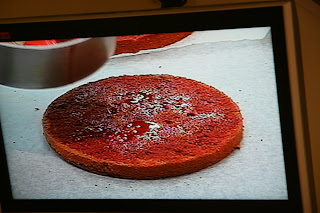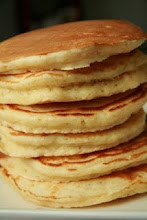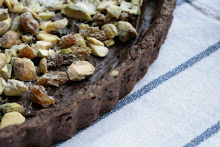Pumpkin pie, the only thing I don't quite like about making this is the prep. Envisioning the steaming and mashing the pumpkin makes me feel exhausted even before I start. And I hate it this morning when I bought the wrong kind of pumpkin that costed me twice as much.
I then digged out my pressure cooker I bought from Shanghai. Although it looks as if was built before WWII, it served me right. Pumpkin was fork-tendered within 10 minutes! Of course darling, you have to cut in pieces so it cooked faster. Dont' throw it in the pot whole as if the knife is non-existent.
 |
| Is this real? |
I usually make the pie crust well ahead of time. It stays fresh in your freezer forever if you handle them properly. I normally fully bake the tart shells, let cool completely and keep in air-tight container like Super Lock container. And put in the freezer. Believe me, it stays good for months.
Sweet pie crust (blind baked)
180 g butter, cold, cubed
340 g cake flour
-----
40 g ground almond
110 g icing sugar
a pinch of salt
-----
80 g of egges (1 large egg + 1 yolk)
In the mixer with paddle attached, beat butter and flour until resembles sand. Add ground almond, icing sugar and salt. Blend swiftly. Add 1 egg first, if it appears that the dough consistency is pliable (looks like play dough), do not add yolk. Blend quickly until just combine. At this point, if the butter starts melting, pat down the dough and wrap with plastic. Rest in the chiller for 10 minutes.
Thinly flour working surface, roll out the dough into 2 mm thick. Line into 10-cm individual tart rings, press and then cut the edge with scraper or with the dull side of your knife. Fork the bottom of the tart shell, rest in the freezer for 5 minutes or in the chiller for 10-15 minutes. Bake at 180 C for 10-12 minutes. Rotate the pan half way through if you spot the tarts are not evenly heated. Let cool.
Filling - makes 13 shells (below recipe yields 1,050 g of batter. Each 10-cm tart shell holds 80 g filling)
425 g of pumpkin, steamed, mashed with fork
3 eggs
70 g light brown sugar
80 g of granulated sugar
1 tsp of cinnamon
1/2 tsp of ginger
1/4 tsp of freshly ground nutmeg
1 tbsp of all purpose flour
1 tsp of vanilla extract
a pinch of salt
---------
120 g of unsweetened evaporated milk
240 g of half and half (or whipping cream)
In the food processor, blend together the first nine ingredients. Then pour in the liquid, or if your food processor is too small, transfer to a bowl and blend well. I incline to infuse the batter overnight for deeper flavor but was too keen to see how it comes out so I decided to bake it right away. The recipes that use brown sugar always make me nervous, I hate to see my goodies discolored. There are quite a few brown sugars in the market, wide variety of different colors, graininess and thus not very easy to judge which one would suit the recipe. I have not many choices though...after one of worst flood hits Bangkok, some of the grocery items suddenly disappear from the shelf....for good.
I compare the result of using dark brown sugar compared with the white one (I didn't have the 'light brown' sugar on hands). Here, I made two batches of batter.
Baking - Bake @160 C for 25-30 minutes just until the rim firm up and the center is still wobble when you shake the tray. Always bake them in the tart pan or they'll break or perhaps leak. Keep in fridge until serve.
All of them tastes really good. The one made with white sugar has lighter taste (I tend to say , compare to their peers it was a bit boring.) while the one with dark brown sugar pronounced spices. Taste wise, I would put the red ribbon to the square tart. Too bad the look doesn't seem to be a winner.
I do love the combination of crispy tart shell and custardy pumpkin. I am glad the tart shell doesn't get soggy the second day around although I put them in a loose plastic wrap in the fridge. Keep in mind as well, you have to keep these tarts in the fridge until just before serving. I put them out on kitchen counter with 27 C room temp, it starts to get soggy.
It tends to weep on the surface when left out on the counter which makes it looks more shiny and I don't mind though as I'll put whipping cream on top at serving. Cook-illustrated recommends to pre-cook the pumpkin puree to get rid of water but I found my homemade puree is too thick and cooking them up would only leave me a messy sticky crust on my pan. But if you find the puree too runny, whether homemade or canned, a good practice is to evaporate some of the excess water.
Spices - The original recipe calls for only 1/2 tsp of cinnamon. I double that up because I felt ginger overly striked my tastes palate....so need to balance that out by adding more cinnamon. I do recommend you always taste the batter before baking and adjust spice according to your liking.
Family size pan - If you make the 10-inch deep dish tart, roll out the dough to 3mm thick so the proportion between thicker custard and the tart shell are satisfyingly-balanced in a bite (I think). The baking times varies, depends upon thickness of the pan. I recommend 40 minutes and check every 5-10 minutes.
| Here is how it looks after baking. |
| With thin maple syrup layer and ginger snap cookies |
| With whipping cream and a touch of cocoa. |
Bon Appetit !











